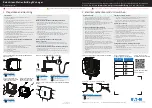
This document is the
Property of Broadband Telecom Power Inc.
and
will not be copied, reproduced, or used as the basis for sale or
manufacture of apparatus or BTCPower without written permission.
BTCPower 350 KW EVSE Installation manual
Draft
Page 4 of 23
WARNING
There are no user serviceable parts inside. For service please contact customer service or your local
distributor.
DO NOT ATTEMPT TO REPAIR THE CHARGE STATION YOURSELF ONLY FACTORY
QUALIFIED PERSONEL.
WARNING
If your supply cable is somehow damaged do not operate your charge station. Contact your service
representative for service immediately. Shut down the power to the unit by switching the breaker on
the supply panel to the off position.
2.
Installation
Safety instructions
The EVSE (Electric vehicle supply equipment) should be installed by a qualified electrician in
accordance with local codes and all applicable ordinances
The charging station is required to be connected to a ground, metal, permanent wiring system.
Connections to the charge station should comply with all local codes and ordinances.
Read all installations instructions carefully prior to performing the installation.
WARNING:
This device utilizes high voltages do not attempt to install this equipment if you are not a qualified
electrician.
2.1 ADA Consideration
STANDARDS FOR ACCESSIBLE DESIGN for Americans with Disabilities is applicable when choosing the location and
placement of all Electric Vehicle Supply Equipment. The following is a direct excerpt from the 2010 ADA Standards for
Accessible Design:
http://www.ada.gov/2010ADAstandards_index.htm
“The Department of Justice published revised regulations for Titles II and III of the Americans with Disabilities Act of
1990 “ADA” in the Federal Register on September 15, 2010. These regulations adopted revised, enforceable
accessibility standards called the 2010 ADA Standards for Accessible Design “2010 Standards” or “Standards”. The
2010 Standards set minimum requirements – both scoping and technical -- for newly designed and constructed or
altered State and local government facilities, public accommodations, and commercial facilities to be readily accessible
to and usable by individuals with disabilities.
Adoption of the 2010 Standards also establishes a revised reference point for Title II entities that choose to make
structural changes to existing facilities to meet their program accessibility requirements; and it establishes a similar
reference for Title III entities undertaking readily achievable barrier removal.





































